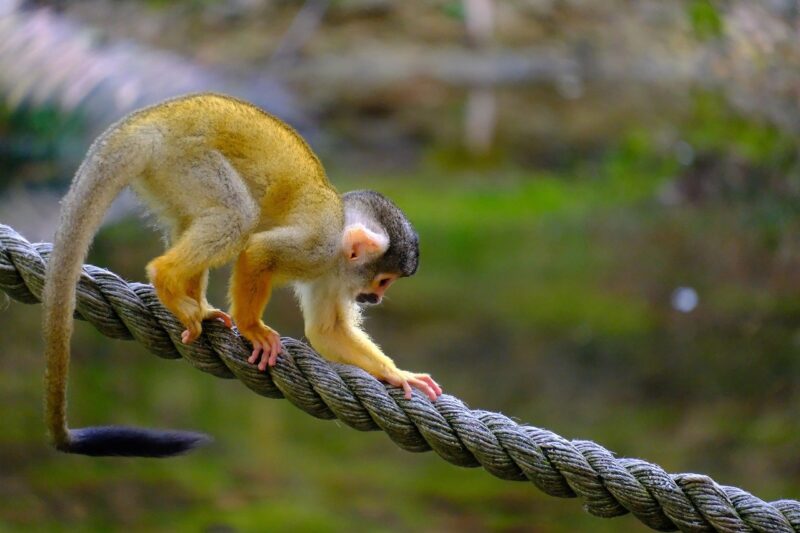How Monkeys Communicate in Complex Social Environments
November 15, 2024

Monkeys are fascinating creatures, known for their intelligence, social structures, and the ability to engage in complex forms of communication. In the wild, they navigate intricate social hierarchies, engage in cooperative behaviors, and utilize their communication skills to establish relationships, warn about dangers, and maintain group cohesion. This article dives deep into the various methods of communication used by monkeys, including vocalizations, gestures, and facial expressions, highlighting their significance in complex social environments.
1. Understanding Monkey Communication
Communication is essential for monkeys, enabling them to express emotions, share information, and maintain social bonds. Different species of monkeys exhibit unique communication methods, influenced by their environments and social structures. Understanding these methods provides insight into their social lives and interactions.
1.1 Vocalizations
Monkeys produce a variety of vocal sounds, each serving different purposes. These may include:
- Alarm Calls: Sharp, loud vocalizations signal the presence of predators, alerting other group members to potential danger. Some species have specific calls for different types of threats, such as aerial predators or ground-based threats.
- Contact Calls: Soft vocalizations maintain cohesion among group members, especially when individuals are separated. These calls help members keep track of one another and strengthen social bonds.
- Food Calls: When monkeys discover food, they use specific calls to notify others, facilitating group feeding. Different calls may be used for different types of food items, demonstrating the sophistication of their communication system.
1.2 Gestures
In addition to vocalizations, monkeys utilize hand signs and body movements to communicate. These gestures can convey a wide array of messages, such as greetings, invitations to play, or threats. Research has shown that hand signals can vary significantly between species and even within groups, indicating their adaptive quality in social interactions.
1.3 Facial Expressions
Facial expressions are also a crucial aspect of monkey communication. Expressions such as baring teeth, lip smacking, or grimacing can denote aggression, submission, or affection. Understanding these expressions is vital for interpreting the emotional states of monkeys and the dynamics of their social interactions.
2. The Role of Social Structures
The complex social structures of monkey groups significantly influence their communication methods. Monkeys often live in societies with defined hierarchies, where status can dictate communication style and content. High-ranking individuals may engage more frequently and dominate interactions, while lower-ranking individuals may rely on different strategies, such as using more submissive postures or avoiding conflict altogether.
2.1 Hierarchical Communication
In hierarchical groups, communication can serve to reinforce social order. High-ranking monkeys may use loud vocalizations and assertive body language to maintain their status, while lower-ranking monkeys might rely more on subtle cues to navigate social tensions. This tiered communication structure helps regulate group dynamics and minimize conflicts.
2.2 Alliances and Cooperation
Monkeys often form alliances to improve their social standing or gain access to resources. Communication plays a vital role in forming and maintaining these alliances, as members need to express trust, offer support, and negotiate conflicts together. Cooperative behaviors, such as grooming or food sharing, are often accompanied by specific vocalizations and gestures that strengthen these social bonds.
3. Learning and Cultural Transmission
Monkeys exhibit behaviors that suggest a degree of cultural transmission, whereby knowledge and communication styles are passed down through generations. Each group may develop unique vocalizations or gestures, reflecting their specific environment and experiences. Such behaviors underline the adaptability of monkey communication and contribute to the diversity of their social interactions.
3.1 Observational Learning
Younger monkeys learn from observing older individuals within their groups. This form of learning extends beyond simple mimicry; young monkeys actively practice communication skills and refine their methods based on social feedback. For example, successful vocalizations that elicit positive responses become reinforced, while ineffective ones may be discarded.
3.2 Innovation and Change
When monkeys encounter new challenges or environments, they may adapt their communication styles accordingly. This innovative behavior showcases their intelligence and social flexibility, as successful adaptations can quickly spread through the group and become established communication norms.
4. The Impact of Environmental Factors
The communication methods of monkeys are also influenced by environmental factors such as habitat, population density, and species-specific traits. For example, in dense forest environments where vocalizations can be obscured, monkeys may rely more heavily on visual signals or tactile communication.
4.1 Habitat Influence
In open habitats, vocalizations may play a more significant role in communication as sound can travel further, while in densest forests, gestures and facial expressions may take precedence. Such adaptations illustrate the importance of flexibility in communication styles based on environmental contexts.
4.2 Population Density and Communication Complexity
High population density can lead to increased competition for resources and necessitate more complex communication strategies. Monkeys living in larger groups may develop richer vocal repertoires to manage interactions, indicating that social structure and environmental context significantly influence communication complexity.
5. Conclusion: The Complexity of Monkey Communication
The study of monkey communication reveals a rich world of social interaction and complexity among these remarkable creatures. With their diverse vocalizations, gestures, and facial expressions, monkeys demonstrate a deep understanding of social relationships and environmental contexts that plays a pivotal role in their survival and social cohesion.
As we continue to research and observe monkeys in their natural habitats, we gain invaluable insights into the intricacies of communication not only among monkeys but also in animal behavior more broadly. Understanding these dynamics offers a glimpse into the evolution of communication, providing new perspectives on both human and animal societies alike.
Ultimately, the communication patterns of monkeys serve as a powerful reminder of the intricate connections between individuals in social environments, showcasing the complexity of life in the animal kingdom.







